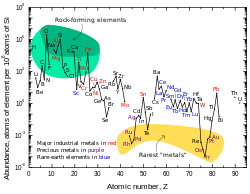Iridium
Iridium is the 77th element on the periodic table. Its symbol is Ir and its atomic number is 77.
Chemistry
Iridium is a metal. Like other metals in the platinum group, Iridium is a rare and expensive "noble metal" and is a transition metal. It looks like platinum and is found in asteroids and comets. It is exceptionally hard-wearing.
Iridium deposits are used to identify relative dates of collisions of foreign bodies. Iridium can fold and bend just like aluminum, and remains very shiny. Most iridium is found in the Americas, though some is mined in Myanmar, South Africa, and Russia. Iridium melts at 2410 °C, and boils at 4130 °C. It is the most corrosion-resistant metal.
Iridium is not needed in the body. It is used for the tips of pens. The main uses of iridium are the metal itself and its alloys.
History
A man named Smithson Tennant first found it in the year 1803 and is was named after Iris in Greek mythology. Smithson Tennant found it in the remains when he left crude platinum in a mixture of hydrochloric acid and nitric acid.
Iridium Media
One troy ounce (31.1035 grams) of arc-melted iridium
Hydrated iridium trichloride, a common salt of iridium.
Cyclooctadiene iridium chloride dimer is a common complex of Ir(I).
Oxidative addition to hydrocarbons in organoiridium chemistry
The Greek goddess Iris, after whom iridium was named.
This alchemical symbol for platinum was made by joining the symbols of silver (moon) and gold (sun).
Antonio de Ulloa is credited in European history with the discovery of platinum.
The Willamette Meteorite, the sixth-largest meteorite found in the world, has 4.7 ppm iridium.
The red arrow points to the Cretaceous–Paleogene boundary.









